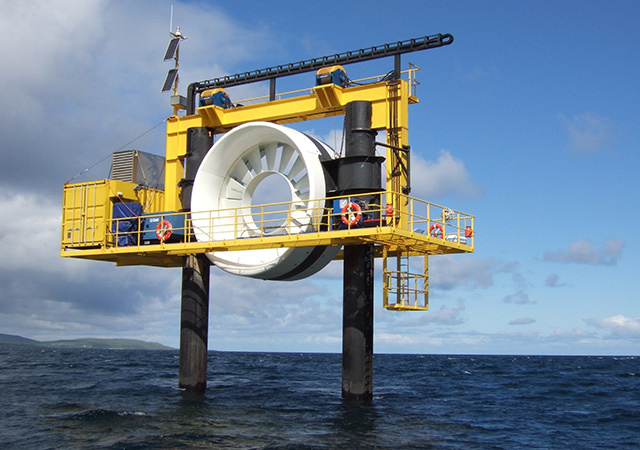
EMEC – the European Marine Energy Centre – on Orkney is a facility Scotland should be proud of. In the nearly 10 years since it opened its doors it has achieved a solid reputation and is now involved in a number of overseas collaborative projects.
This is good for Scotland and good for the marine energy sector.
However, EMEC’s success illustrates the extent to which the industry here in the UK is now increasingly dominated by overseas corporate or other investors.
Going through the list of the companies that have used or are using the Orkney centre, it is really quite surprising as to how remarkably small the Scottish and wider UK content actually is.
Looking first at the wave energy companies who have or are currently testing hardware at EMEC, the first and perhaps best known is Aquamarine of Edinburgh.
The largest investor in Aquamarine appears to be ABB Technology Ventures based in Switzerland which gives Aquamarine access – potentially – to ABB’s huge technology knowledge base. That said the company has also received investment from Scottish Enterprise and Scottish Equity Partners.
Pelamis Wave Power, also based in Edinburgh, initially found a lot of its investment from overseas and, given its chair is also managing partner of Emerald Technology Ventures, the Swiss-based venture capitalist, this would suggest that pattern continues.
It’s also interesting to note that the two companies testing Pelamis devices at EMEC are E.ON (German) and Scottish Power Renewables owned by Iberdrola (Spanish).
A third company, VattenfallB (wholly-owned by the Swedish state), is planning to test the latest generation Pelamis Wave Power device in 2014.
The Finnish company Wello Oy is also testing its wave energy system at EMEC. Having worked on a number of wave energy concepts since 1976 the Penguin model was selected in 2008 to be developed further. Wello Oy is entirely Finnish owned.
AW Energy is also a Finnish company. It is developing the Waverider device, which was successfully tested at EMEC in 2005. The firm now has a project underway – albeit slowly – in Portugal. Needless to say, all main investors are Finnish.
Finally though some good news. Seatricity is a small Orkney-based company developing and testing a new wave device at EMEC and it appears that it may well be that it is actually UK owned.
Turning now to tidal energy devices being trialled, one of the most advanced has been built by Andritz Hydro Hammerfest, which was originally a Norwegian-owned company but it is now owned by the Austrian Andritz Hydro GmbH group.
The Atlantic Resources Corporation (ARC) is also testing a tidal turbine at EMEC. ARC has a project office in London but is essentially a company based in Singapore although it now includes among its investors the Norwegian electricity utility company Statkraft.
Third in our list of tidal energy technology companies is the Dutch company Bluewater Energy Services, which is testing a novel floating tidal generator support device.
Kawasaki Heavy Industries is planning to test a 1Mw tidal generator in 2014 and is currently component testing in Holland, performing tank tests of a scale model, stress tests of blades and power train tests, as well as some component testing for its full-scale prototype. Needless to say Kawasaki is a Japanese company,
OpenHydro has been testing devices at EMEC since 2006, has deployed a device in the Bay of Fundy, Nova Scotia, and is currently working on a project in Brittany, France, where it aims to deploy four 16m tidal turbines. OpenHydro was recently acquired by the major French shipbuilder and marine technology company DCNS SA.
Scotrenewables Tidal Power is a Scottish company that has developed a floating tidal technology device. But its main investors are the Swiss ABB group, the Norwegian Fred Olsen group and the French oil and gas major Total.
Tidal Generation is developing and testing a seabed tidal turbine similar in concept to those of Andritz Hydro Hammerfest and ARC. A Bristol-based company, it was bought by the jet engine builder Rolls Royce in 2009 but it was recently bought from them by the French engineering group Alsthom.
The German company Voith Hydro is working with RWE Innogy through the joint venture Voith Hydro Ocean Current Technologies and currently building a 1MW demonstrator of a seabed turbine due to be tested at EMEC starting this year.
Voith Hydro is also the company responsible for the recent close of the Scottish wave energy company Wavegen and “relocating” its intellectual property and assets to Germany.
When I was asked to analyse EMEC’s customer base even I was not prepared for what it would tell me.
I am actually staggered by the appallingly low level of investment in the sector by UK and Scottish companies even when the technology behind the company involved has been developed by Scottish or UK engineers.
Of course, we can praise EMEC itself for having built a very successful business and for having promoted the huge tidal and wave energy resources that Scotland possesses.
The fact that the centre’s success has exposed another major hole in how we do real economic development isn’t the organisation’s fault. But it is something we should be thinking hard about.
Indeed we should be horrified by our record so far. I certainly am.
Recommended for you
